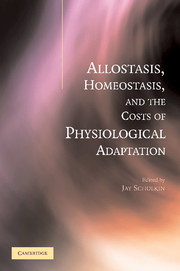Book contents
- Frontmatter
- Dedication
- Contents
- Preface
- Contributors
- Introduction
- 1 Principles of Allostasis: Optimal Design, Predictive Regulation, Pathophysiology, and Rational Therapeutics
- 2 Protective and Damaging Effects of the Mediators of Stress and Adaptation: Allostasis and Allostatic Load
- 3 Merging of the Homeostat Theory with the Concept of Allostatic Load
- 4 Operationalizing Allostatic Load
- 5 Drug Addiction and Allostasis
- 6 Adaptive Fear, Allostasis, and the Pathology of Anxiety and Depression
- 7 A Chronobiological Perspective on Allostasis and Its Application to Shift Work
- 8 Allostatic Load and Life Cycles: Implications for Neuroendocrine Control Mechanisms
- Commentary: Viability as Opposed to Stability: An Evolutionary Perspective on Physiological Regulation
- Index
4 - Operationalizing Allostatic Load
Published online by Cambridge University Press: 05 February 2015
- Frontmatter
- Dedication
- Contents
- Preface
- Contributors
- Introduction
- 1 Principles of Allostasis: Optimal Design, Predictive Regulation, Pathophysiology, and Rational Therapeutics
- 2 Protective and Damaging Effects of the Mediators of Stress and Adaptation: Allostasis and Allostatic Load
- 3 Merging of the Homeostat Theory with the Concept of Allostatic Load
- 4 Operationalizing Allostatic Load
- 5 Drug Addiction and Allostasis
- 6 Adaptive Fear, Allostasis, and the Pathology of Anxiety and Depression
- 7 A Chronobiological Perspective on Allostasis and Its Application to Shift Work
- 8 Allostatic Load and Life Cycles: Implications for Neuroendocrine Control Mechanisms
- Commentary: Viability as Opposed to Stability: An Evolutionary Perspective on Physiological Regulation
- Index
Summary
INTRODUCTION
In elderly populations, comorbidity in the form of multiple co-occurring chronic conditions is the norm rather than the exception. For example, in the United States, 61% of women and 47% of men aged 70 to 79 report two or more chronic conditions. These figures rise to 70% of women and 53% of men aged 80 to 89 with 2+ chronic conditions (Jaur and Stoddard, 1999). No single form of comorbidity occurs with high frequency, but rather a multiplicity of diverse combinations are observed (e.g., osteoarthritis and diabetes, colon cancer and coronary heart disease, depression and osteoporosis). This diversity underscores the need for an early warning system of biomarkers that can signal early signs of dysregulation across multiple biological systems.
One response to this challenge was the introduction of the concept of allostatic load (McEwen and Stellar, 1993; McEwen, 1998; McEwen and Seeman, 1999) as a measure of the cumulative biological burden exacted on the body through attempts to adapt to life's demands. The ability to adapt successfully to challenges has been referred to as allostasis (Sterling and Eyer, 1988; McEwen, 2002; Schulkin, 2003). This notion emphasizes the biological imperative that, to survive, “an organism must vary parameters of its internal milieu and match them appropriately to environmental demands” (Sterling and Eyer, 1988). When the adaptive responses to challenge lie chronically outside of normal operating ranges, wear and tear on regulatory systems occurs, and allostatic load accumulates.
Dysregulation in one or more of the biological systems involved in allostasis is reflected in characterizations of the multiple pathways to patho-physiology and a diversity of chronic conditions. Thus, any operationalization of the concept of allostatic load should signal pending onset of diverse kinds of disability and disease. In addition, allostatic load, measured at any age or via longitudinal assessments, should represent the biological signature of cumulative antecedent challenges.
- Type
- Chapter
- Information
- Publisher: Cambridge University PressPrint publication year: 2004
- 32
- Cited by



